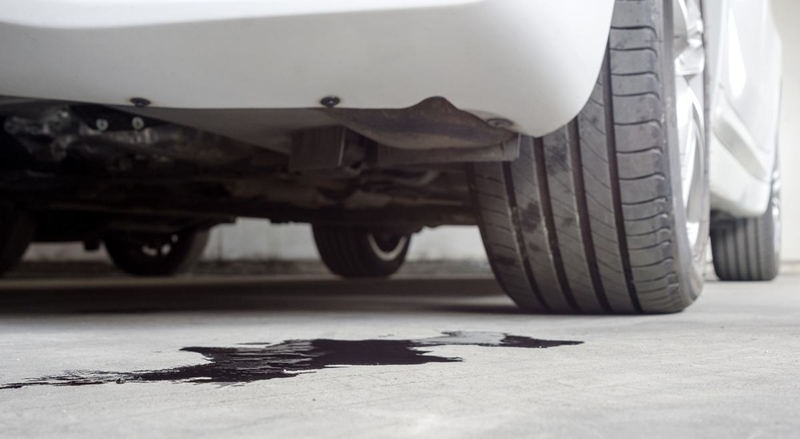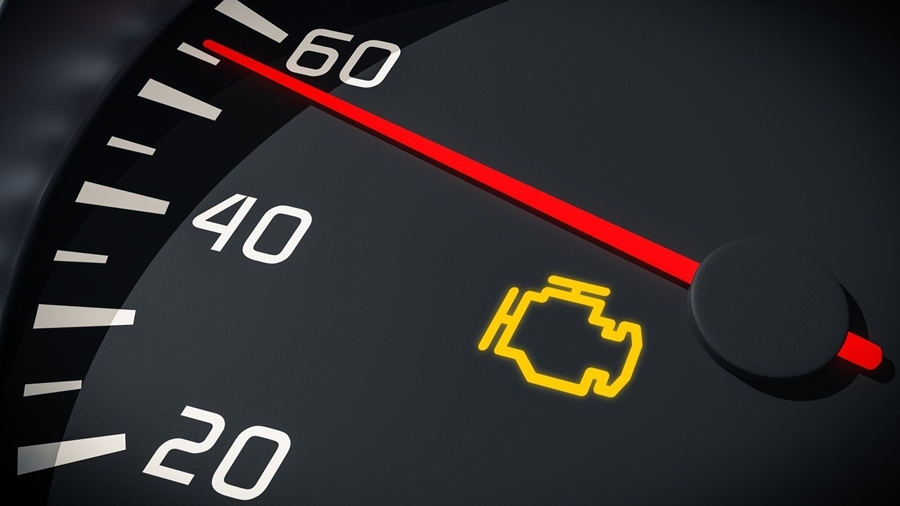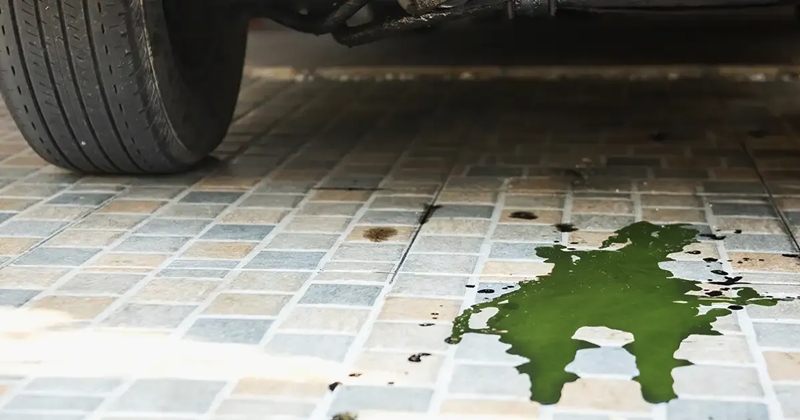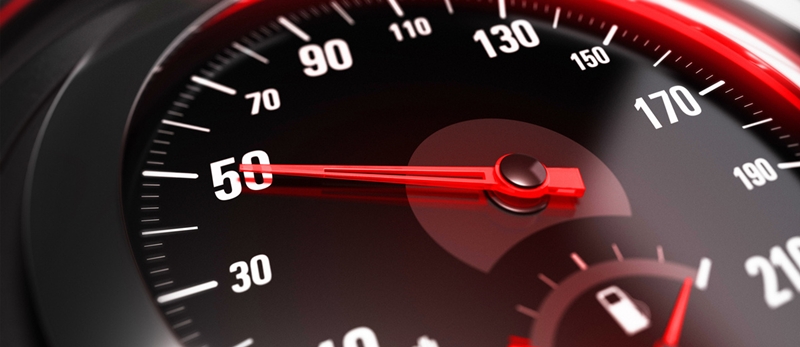Something leaking under car: Many drivers tend to overlook small leaks in their vehicles, often assuming that they are insignificant and can be ignored. However, this negligence can lead to much larger, more costly problems down the road. Addressing leaks at their early stages can not only save you a substantial amount of money in repairs but also ensure that your vehicle remains safe and reliable for your journeys.
Table of Contents
The Importance of Recognizing Leaks Based on Color
When fluid leaks occur, the color of the leaking fluid can provide critical information about the nature of the problem. Each color corresponds to a specific type of fluid, and recognizing what each color signifies can help you quickly ascertain the issue at hand—allowing for faster and more effective responses.
Understanding how to identify leaks based on their color is an essential skill for any vehicle owner. It empowers you to make informed decisions about whether a simple, quick fix is sufficient or if the situation warrants a visit to a professional mechanic.
Also read: 8 Critical Engine Coolant Colors Every Car Owner Must Know to Avoid Disaster
The Goal of This Guide
This guide aims to provide you with a comprehensive overview of the various fluids that are essential for your vehicle’s operation, what their distinctive colors indicate about their condition, and how to effectively spot leaks before they escalate into major headaches that could disrupt your day.
By being proactive and knowledgeable about these signs, you can maintain your vehicle’s performance and longevity, ensuring that you stay safe on the road.
Understanding Vehicle Fluids and Their Functions
The Role of Different Fluids in Vehicle Operation
Cars rely on several key fluids to run smoothly. Each has a specific job:
- Engine Oil: Keeps the engine parts lubricated and prevents overheating.
- Transmission Fluid: Helps gears shift smoothly and protects transmission parts.
- Coolant: Regulates engine temperature, preventing it from overheating.
- Brake Fluid: Powers the brake system, making stopping possible.
- Power Steering Fluid: Assists in turning the wheel easily.
- Windshield Washer Fluid: Cleans the windshield for clear visibility.
Importance of Fluid Color in Diagnostics
When a leak occurs in your vehicle, the color of the fluid that escapes can provide crucial insights into what exactly is leaking. Each type of automotive fluid has a distinct color and consistency, which can serve as a diagnostic tool for identifying potential issues.
For instance, engine oil typically appears amber to dark brown, while coolant is usually a bright green, orange, or pink. Transmission fluid often has a reddish hue, and brake fluid may be clear to yellowish. By observing changes in color or noticing the presence of unfamiliar fluid on the ground, vehicle owners can pinpoint specific problems that may arise in their cars.
Also read: Rad Fluid Leak Guide: Causes, Signs, and Solutions
Detect Problems Early
Recognizing these clues early is not just a matter of convenience; it can significantly prevent larger, more costly issues from developing. For example, a small oil leak, if detected early, can often be repaired with minimal expense, whereas ignoring it could lead to severe engine damage that necessitates a complete overhaul or replacement.
Similarly, a brake fluid leak could compromise the braking system, resulting in brake failure, which poses a serious safety risk. By being vigilant and proactive about monitoring fluid leaks, drivers can maintain their vehicle’s performance and safety, thus ensuring a longer lifespan for the car.
Use Fluid Color to Detect the Problem
Experts in automotive maintenance and repair consistently emphasize the importance of spotting leaks early based on fluid color. This practice not only helps keep your vehicle running longer and smoother but also contributes to overall vehicle safety and reliability.
Regular checks for leaks, combined with routine maintenance, can lead to a more enjoyable driving experience and peace of mind for the owner.
Moreover, understanding the significance of fluid colors can empower vehicle owners to take informed actions, whether that means scheduling a service appointment or addressing minor issues before they escalate into major repairs.
Common Leak Types and Corresponding Fluid Colors
Engine Oil Leaks
Typical Color: Amber or Brown
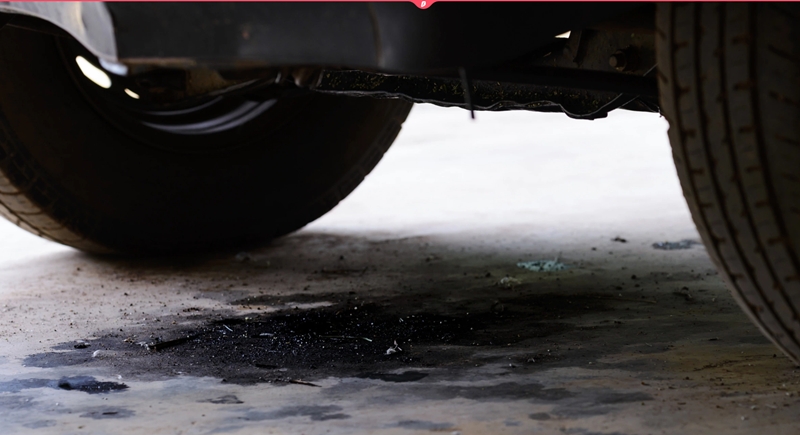
Fresh engine oil usually looks like honey, with a bright amber color, showing it’s clean and doing its job well in keeping engine parts moving smoothly. As the oil moves around your engine, it starts to break down because of heat, dirt, and stuff from burning fuel. This makes the oil turn a dark brown shade, which means it might not be protecting your engine as well anymore.
Causes of Engine Oil Leaks
If you spot dark, oily patches under your car, it’s often a sign that your engine oil is leaking. These leaks often happen because of a worn-out gasket, which seals engine parts together, or a loose drain plug that wasn’t tightened properly after an oil change. It’s important to keep an eye out for other warning signs. For example, if you hear strange noises like the engine knocking, it might mean the oil isn’t doing its job, which could lead to major damage.
How To Check Your Engine Oil
Also, if your car feels like it’s pulling to one side while driving, it’s a good idea to safely pull over and check the oil level and color. To do this, find the dipstick (it’s usually easy to spot), pull it out, wipe it clean, and put it back in to get a clear reading. When you pull it out again, check how the oil looks and feels. If it’s really dark or gritty, it’s a sure sign it’s time for an oil change.
Keeping up with regular maintenance and changing the oil on time is key to keeping your engine running well and avoiding expensive repairs later.
Transmission Fluid Leaks
Typical Color: Bright Red or Pink

Clean transmission fluid is usually bright red or pink, showing it’s in good shape and doing its job well in keeping the transmission system running smoothly. This bright color comes from additives that stop oxidation and keep the fluid protective.
Over time, as the fluid deals with heat and contaminants, it starts to darken, turning a deeper red or even brownish, but it generally keeps some of its original color. If you notice red fluid under your car, that’s a likely sign of a transmission leak. These leaks can happen due to worn seals, gaskets, or even damage to the transmission casing. It’s important to fix these leaks quickly because losing transmission fluid can seriously mess with how your car performs.
Other Signs of Transmission Problems
Besides noticing the color, there are other signs that might point to transmission fluid problems. You might feel the gears slipping, where the transmission suddenly changes gears or doesn’t engage right, causing a loss of power and control. Delayed shifting is another issue, where there’s a noticeable delay between hitting the gas and the car responding, showing the transmission is having trouble shifting smoothly.
Keep Your Transmission Healthy
To keep your transmission system healthy, it’s key for car owners to regularly check the fluid levels and watch for any changes in color or consistency. A sudden color change, especially if it turns dark or smells burnt, can be an early sign of internal transmission problems.
Regular checks can catch these issues early, possibly saving you from expensive repairs and helping your transmission last longer. By staying on top of the transmission fluid’s condition, drivers can enjoy a smoother and more reliable ride.
Coolant Leaks
Typical Color: Bright Green, Orange, Pink, or Blue
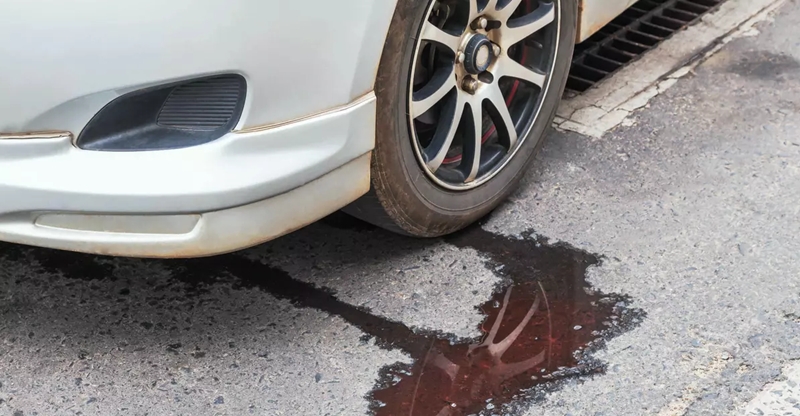
Coolant, often called antifreeze, is super important for keeping your car’s engine running smoothly and lasting longer by managing its temperature. This special fluid moves through the engine, soaking up heat and stopping it from overheating, which could cause major engine damage.
Typical Anti-Freeze Colors
Coolant comes in different colors like green, orange, pink, and blue, each showing a different mix of chemicals made to fit specific engine needs and performance standards. Knowing these differences helps you pick the right one for your car, making sure it runs great and stays protected.
Watch for Other Signs
When you’re doing routine car checks, keep an eye out for any signs of coolant leaks, as these can lead to big engine issues if ignored. A common sign of a leak is finding puddles or spots under your car. These puddles usually have a sweet, syrupy smell, which is typical of ethylene glycol, a main ingredient in many coolants.
If you catch this sweet scent, it’s a key warning that can help you spot leaks early, potentially saving you from serious damage and costly repairs later on.
Check Your Temperature Gauge
Besides looking for leaks, watching your dashboard’s temperature gauge is crucial for keeping your engine healthy. If the gauge starts climbing unexpectedly, it might mean your engine is overheating, possibly due to low coolant levels.
This can happen because of leaks, evaporation, or poor upkeep. Ignoring these warning signs can lead to big, expensive problems like warped cylinder heads, blown head gaskets, or even total engine failure. So, it’s really important to fix any coolant leaks quickly and make sure your cooling system is working right to avoid these pricey issues.
Importance of Regular Inspections
Regularly taking care of your car’s cooling system, like checking coolant levels and inspecting hoses and connections, can help prevent leaks and keep your engine at a safe temperature. By staying on top of these details, you can make your engine last longer and keep your car running well.
Consequences of Coolant Leaks
Over time, low coolant can cause the engine to overheat, which might result in major damage like a blown head gasket, warped cylinder heads, or even a total engine failure. So, it’s crucial to deal with any signs of coolant leaks right away.
Preventing Coolant Leaks
Regular maintenance checks, like looking at hoses and connections for any wear and tear, can help stop these leaks before they start. Plus, making sure your coolant is at the right level and changing it according to the manufacturer’s guidelines will help keep your engine running smoothly and extend your car’s life.
Brake Fluid Leaks
Typical Color: Clear to Light Amber
Brake fluid usually looks clear to pale yellow or amber, which can give you a quick clue about its condition. This fluid is super important for making sure your car’s brakes work right. It helps send the force from your foot on the brake pedal to the actual brake parts, allowing you to steer and stop effectively.
Keep Your Brake Fluid in Good Shape
Because it’s hydraulic, brake fluid can transfer pressure efficiently, which is key for making sure your brakes engage when you need them. However, over time, it can absorb moisture from the air, which lowers its boiling point and might cause rust in brake parts. So, keeping your brake fluid in good shape is crucial for safety.
Changes in color can mean the fluid is contaminated or breaking down, which can lead to big safety problems if ignored. Regularly checking your brake fluid and the whole brake system is key to keeping things running smoothly and safely on the road.
Signs of Brake Fluid Leaks
If there’s a leak in the brake system, you’ll notice a few things. A common sign is a spongy brake pedal, which feels softer than usual when you press it. This might mean air or moisture has gotten into the system.
A soft brake pedal can also mean there’s not enough fluid pressure, which can mess with your braking and make it take longer to stop. If you see your brake fluid level dropping a lot or notice it getting darker or cloudy, it’s time to get your brakes checked by a pro mechanic ASAP.
Power Steering Fluid Leaks
Typical Color: Clear to Amber
Just like brake fluid is key for your car’s brakes to work safely, power steering fluid is super important for smooth and easy steering. This fluid is usually clear or light amber, which means it’s in good shape.
Other Signs of Power Steering Issues
But if you start having trouble steering—like it feels heavy, stiff, or not as precise as usual—it might mean there’s a problem with the power steering system. Also, if you hear whining or groaning noises when you turn the wheel, it could be because the power steering pump is having a hard time, possibly due to low fluid or a malfunction.
These noises often pop up when the fluid is low, and ignoring them can cause bigger issues. If you notice the fluid level dropping fast, you probably have a leak somewhere, like in the hoses, the pump, or the steering gear.
Check Your Power Steering Fluid Regularly
It’s crucial to find and fix any leaks before just topping off the fluid. Ignoring the real problem and just adding more fluid can make things worse, leading to more damage and expensive repairs. So, it’s a good idea to regularly check your power steering fluid levels and look out for leaks or other issues to keep your steering in top shape and make sure your car’s steering system lasts.
Windshield Washer Fluid Leaks
Typical Color: Bright Blue, Green, or Purple
Washer fluid is usually that blue or green stuff you spot easily among other car fluids. While it might not be as crucial as engine oil or coolant, it’s still key for keeping your windshield clear and your drive safe.
Its main job is to clean the windshield by getting rid of dirt and grime that can mess up your view of the road. If there’s a leak in the washer fluid system, you’ll likely notice puddles near the wheels or a mist when you spray it on the windshield. These leaks can happen because of things like a cracked reservoir, busted hoses, or loose connections.
Checking For Leaks is Easy
Luckily, spotting and fixing these problems is often a breeze. Just check the hoses and the reservoir for any obvious leaks. Usually, swapping out a damaged hose or tightening a loose fitting can get things back to normal without needing a pro.
Refill Your Washer Fluid Regularly
Also, make sure to regularly check and refill your washer fluid, especially before long trips or when the weather’s bad. Keeping the washer fluid system in good shape not only boosts safety but also helps with the overall upkeep of your car, making sure everything runs smoothly.
Also read: Why Do Cars Overheat: 12 Shocking Reasons (And How to Fix Them)
How to Diagnose Vehicle Fluid Leaks Step-by-Step
- Visual Inspection Techniques
First, safely jack up your vehicle if needed. Look underneath for puddles matching fluid colors. Use a flashlight to identify small leaks or drips. For stubborn leaks, UV dye can be added to fluids to help you spot leaks with a UV light.
- Fluid Level and Color Check
Regularly check fluid levels and look at their colors during routine maintenance. Keep a record of any changes. A sudden drop in fluid level or a shift in color can point to trouble ahead. Use the right tools, like dipsticks and funnels, for accuracy.
When to Seek Professional Help With Your Vehicle
If you notice anything weird like puddles under your car, oil floating on top, or a sudden change in the color of fluids under the hood, you should definitely call a mechanic right away. These signs usually mean there’s something wrong, and if you ignore them, it could turn into a big problem that messes with your car’s performance.
Not dealing with leaks can lead to major engine damage or even brake failure, which is a huge safety risk for you and everyone else on the road. Besides engine and brake issues, leaks can also affect other important systems like your transmission and cooling systems, leading to expensive repairs and possibly leaving you stranded. So, it’s smart to act fast.
Find a Trusted Mechanic
Get in touch with a trusted auto repair shop or a mobile mechanic who can figure out what’s going on. These pros know how to spot both obvious and hidden leaks using special tools and diagnostics to find out exactly where the problem is and how to fix it.
A good mechanic will also explain what’s happening, why it matters, and how they’re going to fix it, which helps build trust and keeps you informed about your car’s health.
Regular maintenance, like checking fluid levels and looking for leaks, can help you avoid these issues altogether. By staying on top of your car’s condition, you can prevent unexpected breakdowns and enjoy a safer drive.
Preventative Measures and Tips
Keeping your car in good shape is key to making sure it lasts a long time and runs smoothly. By taking some smart steps, you can avoid those annoying breakdowns and expensive fixes. Here are some handy tips to help you keep your ride in top-notch condition.
- Stick to your car’s maintenance schedule. Your owner’s manual has all the info you need for your car’s specific maintenance timeline. This usually covers important stuff like oil changes, tire rotations, and brake checks. Following these schedules can stop small problems from turning into big headaches, making your drives smoother and safer.
- Go for high-quality fluids and filters. The fluids and filters you use can really affect how well your car runs. Choosing top-notch motor oil, transmission fluid, brake fluid, and coolant can boost engine performance and extend its life. Plus, using good filters, like oil, air, and fuel filters, helps keep dirt and junk out, letting your car run at its best.
- Check fluid levels regularly, especially before long trips. It’s a good idea to routinely check your fluids, especially before hitting the road for a long drive. This means checking engine oil, coolant, brake fluid, power steering fluid, and windshield washer fluid. Keeping these at the right levels helps everything work efficiently and prevents overheating or engine trouble during long trips.
- Watch fluid colors for any changes. Keeping an eye on the color and look of your car’s fluids can give you a heads-up on potential issues. For example, new engine oil is usually amber, but it gets dark and gritty when used. Coolant should be bright and clear; any cloudiness might mean contamination. Spotting these changes early can help you fix problems before they get serious.
- Dispose of used fluids properly to protect the environment. Being environmentally responsible is important when maintaining your car. Used fluids like oil and antifreeze can be harmful if not disposed of correctly. Many auto parts stores and service centers have recycling programs for these, ensuring they’re handled safely. By disposing of these materials properly, you help protect the environment and contribute to community safety.
Need a mechanic? Find one on the Mobile Mechanic Directory
Final Thoughts: Something Leaking Under Car
Spotting leaks early by carefully observing the color of fluids can save you from significant headaches and financial burdens in the long run. Understanding what each color signifies is a straightforward yet effective strategy to maintain your vehicle’s health and performance.
- By being proactive and regularly checking for these signs, you can take quick action to address any problems before they escalate into costly repairs that could leave you stranded or facing extensive damage. Regular inspections of your vehicle’s undercarriage and parking area can help you identify leaks early, allowing you to tackle potential issues head-on.
- Remember: it’s always better to check your vehicle’s fluids frequently than to deal with the repercussions of neglecting small issues that can lead to severe damage over time. Maintaining a routine for fluid checks—such as engine oil, coolant, brake fluid, and transmission fluid—can greatly enhance your car’s longevity and reliability.
- Stay vigilant, and your car will thank you with long-lasting performance, improved fuel efficiency, and enhanced safety on the road. In addition, keeping a maintenance log can help you track fluid levels and service intervals, ensuring that your vehicle remains in optimal condition. Ultimately, a little diligence goes a long way in preserving your vehicle’s integrity and functionality.

